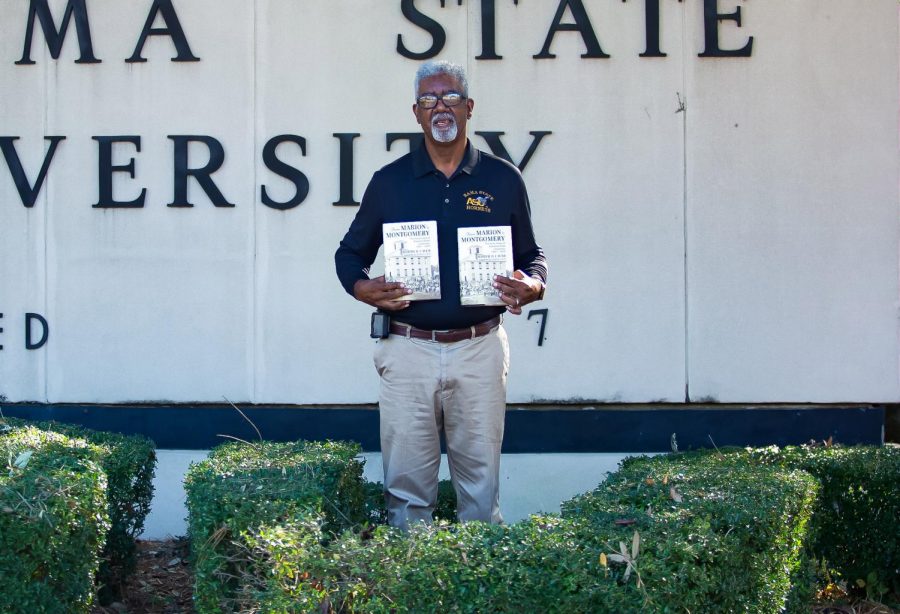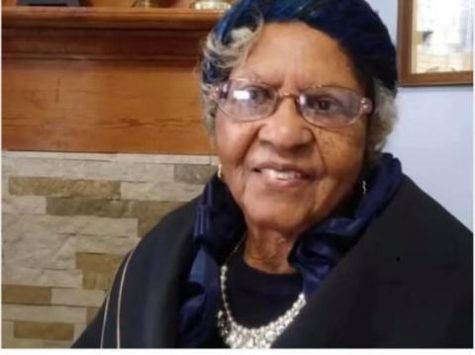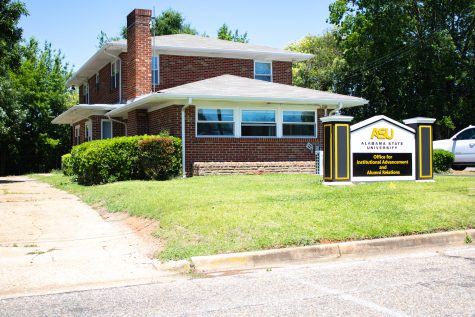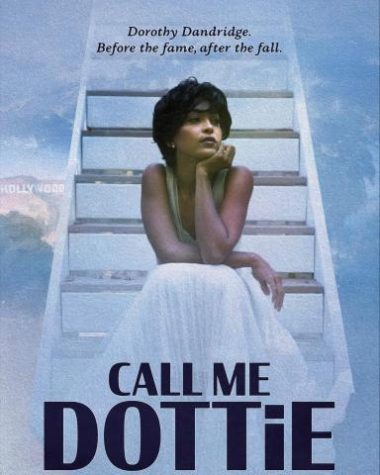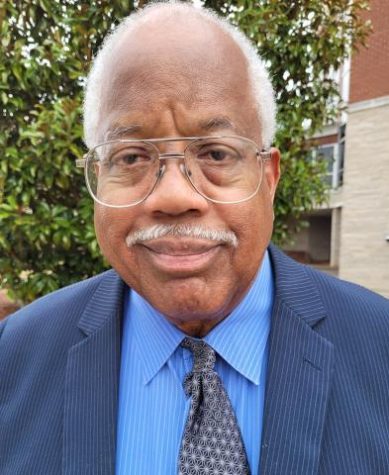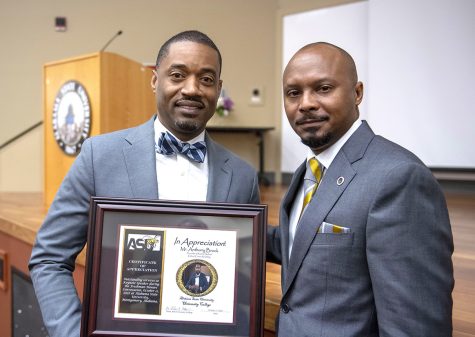Caver releases a new book recounting the early history of Alabama State University
Caver’s book weaves and illuminates ASU’s history with rich details and vivid images of how nine freedmen (The Marion Nine) in Marion, Ala., founded the Lincoln Normal School, which later moved to Montgomery and is now known as Alabama State University
Releasing his second book in November of 2020, alumnus Joseph D. Caver displays copies of his book, “From Marion to Montgomery: The Early Years of Alabama State University, 1867-1925” that are available for purchase on multiple platforms, and hopefully exclusive access to Alabama State University students.
November 19, 2020

Because many college students are now attending classes in a pandemic, and to some degree confined to their living quarters, it is easy for one to simply pass a person on campus wearing a mask without considering his or her role at the university. This is the case of many students who attend Alabama State University.
Because of his calm, distinguished, but affable attitude, one glance at Joseph Caver would never reveal that students were in the presence of one of the most notable historians in the state of Alabama. He is a renowned archivist, author, and the man that shaped the way that people recognize and honor Alabama State University.
There may be a few freshmen who may be familiar with his name, due to the textbook required for the freshman orientation classes, who may have taken the time to read of Caver and his contributions to Alabama State University’s history, but very few. However, Caver’s work changed the way students have learned the history of Alabama State University.
Caver’s own story begins in Autauga County and goes on past basic knowledge.
Caver recounts memories from his childhood that he credits to his love of history. As a young child growing up in Independence, Ala. (located in Autauga County), Caver would visit his paternal grandfather every Saturday morning. During these visits, he would shave his grandfather’s head in the manner that his grandfather desired, and as payment, Willie Lee Caver (his grandfather) would grant the young Caver with 50 cents and stories of their family’s past.
“He was a great storyteller,” Caver said. “His stories about his childhood always intrigued me. When I visited him, he did most of the talking and I did most of the listening.”
Those weekly conversations were the start of his long and successful career of studying not only local history but also Alabama history, along with the role of African Americans in the South. Though his grandfather and parents had only advanced to a grade school level education, Caver was able to graduate from Hicks Memorial High School (now known as Autaugaville High School) in 1970 and followed in his eldest sister’s footsteps by furthering his own education at Alabama State University.
He joined the Hornet family in the Fall of 1970 with his future already decided.
“When I got to Alabama State there was no doubt that I wanted to major in history,” Caver said.
Realizing that his arrival would succeed classes of students that played keys roles in the advancements of civil rights in Alabama history, it was only right that he held high expectations for his own college experience.
“My class thought we could change the world,” he laughed as he spoke, “and we set out to do it! Nobody told us that we were foolish or that we couldn’t…”
This is the attitude that guided him through his first four years as a Hornet. He spoke of various professors and courses that only added fuel to his love for antiquity: Norman Walton, Ph.D., Thelma Glass, M.A., and many more.
“All the faculty just nurtured me, and they pushed me … to write that thesis,” Caver said. The same thesis, years later, would play a major role in his career.
Shortly after graduating Caver married his college sweetheart, Mary Louise Wright-Caver, and was hit with the harshness of “reality.”
“I graduated in 1974 with a degree in history and couldn’t get a job,” he reminisced.
Caver worked for a short amount of time as a teacher, certified to specifically instruct students with special needs. Soon after, he received a call about an open position as an archivist for the Alabama Department of Archives and History (ADAH). Because he was the 13th person to be interviewed, they asked him one question: Have you done any research on Alabama history? Fortunately, for him, he was able to quickly narrate a research paper that he had written for Dr. William Harper’s colonial history class during his time at ASU. Caver was offered the job, making him the first black archivist for the state of Alabama in his early twenties.
His work as an archivist only strengthened his passion for history and put him in a position where he could study any subject regarding the state’s history at any time. It was here where he gained an interest in Alabama State University’s history.
Initiated by an Auburn graduate student, Caver was exposed to the American Missionary Association papers that eventually led him to information about Lincoln School in Marion, the direct ancestor of ASU. This newfound information led Caver back to his alma mater to obtain his master’s degree in history, where he was required to write a thesis, “From Marion to Montgomery: A Twenty-Year History of Alabama State University, 1867,” which focused on the Lincoln School in Marion and its first 20 years before its exodus to Montgomery. This infamous thesis would serve as the blueprint to a much larger project which would occur later in his life.
From then on, Caver became an expert in certain areas of history and a consultant for legal trials, and was utilized for many projects such as Alabama Public Television’s documentary “Where We Once Stood.”
In 1981 he received a job as an archivist for the Air Force Historical Research Agency. It was here where he became familiar with the legacy of the Tuskegee Airmen. In his preface, Caver quotes, “While working at the agency, I served as the Chief of Circulations and answered thousands of queries on the Tuskegee Airmen. This position led to my providing Lucas Films with documentation on the Tuskegee Airmen for the movie “Red Tails (2012).” Caver played a major part in the accuracy and making of a multi-award winning, $50 million box office hit! Because he was able to recover so much documentation and provide so much research on the topic, he was able to co-write and publish his first book.
In 2011 Caver released “The Tuskegee Airmen, an Illustrated History: 1939-1949.” Almost like a chain reaction, the success of this publication led to even more work for the Tuskegee Airmen and the hopes of a publication of another book.
Following the success of his first publication, Caver’s publicist urged him to expand his original thesis, “From Marion to Montgomery: A Twenty-Year History of Alabama State University, 1867-1887.” Even in its original thesis form, the text uncovered information that not only impacts the university, but also reflects the role of African Americans in the south during the 18th and 19th centuries.
Before the release of his thesis, it was accepted that Alabama State University was founded in 1874 by William Burns Paterson, a Scottish man that believed in the potential and advancements of African Americans. Caver’s thesis challenged that belief.
The thesis traces the university back to the Lincoln School of Marion, a private school for blacks started by nine former slaves in 1867. The paper identifies the nine men who endorsed the school, the social struggles of the school in the rural south, federal funding obstacles, and more.
Kenneth Dean, university coordinator of student media, remembers being a student and being impacted by the thesis.
“Imagine being taught for years that Paterson was the founder of the university, only to find out that nine black men actually founded the university,” Dean said. “Remember, this was just two years after the Civil War. During that time, the Klu Klux Klan, a domestic terrorist organization would kill and lynch blacks for making any kind of effort to increase the quality of life for black folk, let alone educating them.”
These kinds of revelations are what encouraged Caver to expand his findings, he felt the need for this to be nationally known, not just a university secret.
 Releasing his second book in November, 2020, Caver’s book “From Marion to Montgomery: The Early Years of Alabama State University, 1867-1925” will be available for purchase on multiple platforms, and hopefully exclusive access to Alabama State University students.
Releasing his second book in November, 2020, Caver’s book “From Marion to Montgomery: The Early Years of Alabama State University, 1867-1925” will be available for purchase on multiple platforms, and hopefully exclusive access to Alabama State University students.
“My publisher thinks because of the time we’re living in, the book will become a national seller due to its emphasis on historically black colleges and universities,” Caver said. The book has already received exceptional reviews from a community of writers who specialize in history and racial conflicts.
Following the success of his first publication, Caver’s publicist urged him to expand his original thesis, “From Marion to Montgomery: The Early Years of Alabama State University, 1867-1925.” The text uncovered information that not only impacts the university, but also reflects the role of African Americans in the south during the 18th and 19th centuries.
“Joseph Caver’s long-awaited history of Alabama State University fills a big need in our understanding of the history of blacks in higher education in the South between Reconstruction and the 1920’s. Full of rich detail, vivid portraits, and astute analysis, Caver’s study helps understand the huge obstacles that existed and were largely overcome, by determined African Americans in Alabama. Every reader will learn much from it.” –Robert J. Norrell, author of “Up from History: The Life of Booker T. Washington.”
“Crisply written and attractively illustrated, “From Marion to Montgomery” is a sympathetic, even loving overview of the first sixty years of what is now Alabama State University. The determined labors of ASU’s early leaders, in the face of almost constant adversity, well deserve the recognition Joe Caver has given them, as well as our admiration.” –Edwin C. Bridges, Director Emeritus, Alabama Department of Archives and History
Caver’s work made a considerable impact on the people in his personal circle. His youngest brother, Eric Caver, was born while he was a student at ASU; resulting in a relationship that the younger considered to be more like having a cool uncle more than as an older brother. He remembers growing up listening to his older brother’s research and stories, similar to the way Caver listened to their own grandfather as a child.
“Because Joseph is a historian, there are not many conversations that we have where something about history does not come up,” Eric Caver said. “He is a true history buff,” as he shares how Caver always has a story to share, whether it is at Thanksgiving dinner or on the way to a football game.
Being a graduate of the university himself, Eric Caver is especially excited for the release of “From Marion to Montgomery: The Early Years of Alabama State University, 1867-1925.”
“I’m excited as a Hornet, as a family of Hornets, and as an involved supporter of the university … I’ve read some of the pieces that he’s sent me, just as a ‘Hey, read this and tell me what you think?” Eric Caver admitted, “but I have purposely not read the book, I am waiting until it is released so that everyone can enjoy it, but I look forward to reading it.” Eric Caver along with the other five Caver siblings are arguably the biggest anticipators of this great release.
Though Joseph Caver is destined for praise for his research and novels, he makes it clear that his motives for his work are purely stemmed from his love for history, and his love for sharing history. To his publisher’s discontent, he does not plan on publishing any more books any time soon; he would rather spend his time participating in programs in his community, church, and at the Hornet’s Nest.
“It is a work of love, and I especially enjoy sharing this with young people who have an appreciation for history … I do it for the students,” Caver said. It is for this reason that, among all his success, he continues to return to Alabama State University to teach one class a semester, not for the money, but for the impact, as he sees the same fire in current students that he saw in the 1960’s during the Civil Rights Movement, the same fire that he had in 1970 when he felt that he could ‘change the world’.
“The battle that we’re fighting is no different in 1960 than it is in 2020,” Caver compares, “I get a sense that you all are ready to jump off, to take off downtown to participate in protests and marches; to move for a change. It is left to this generation …


